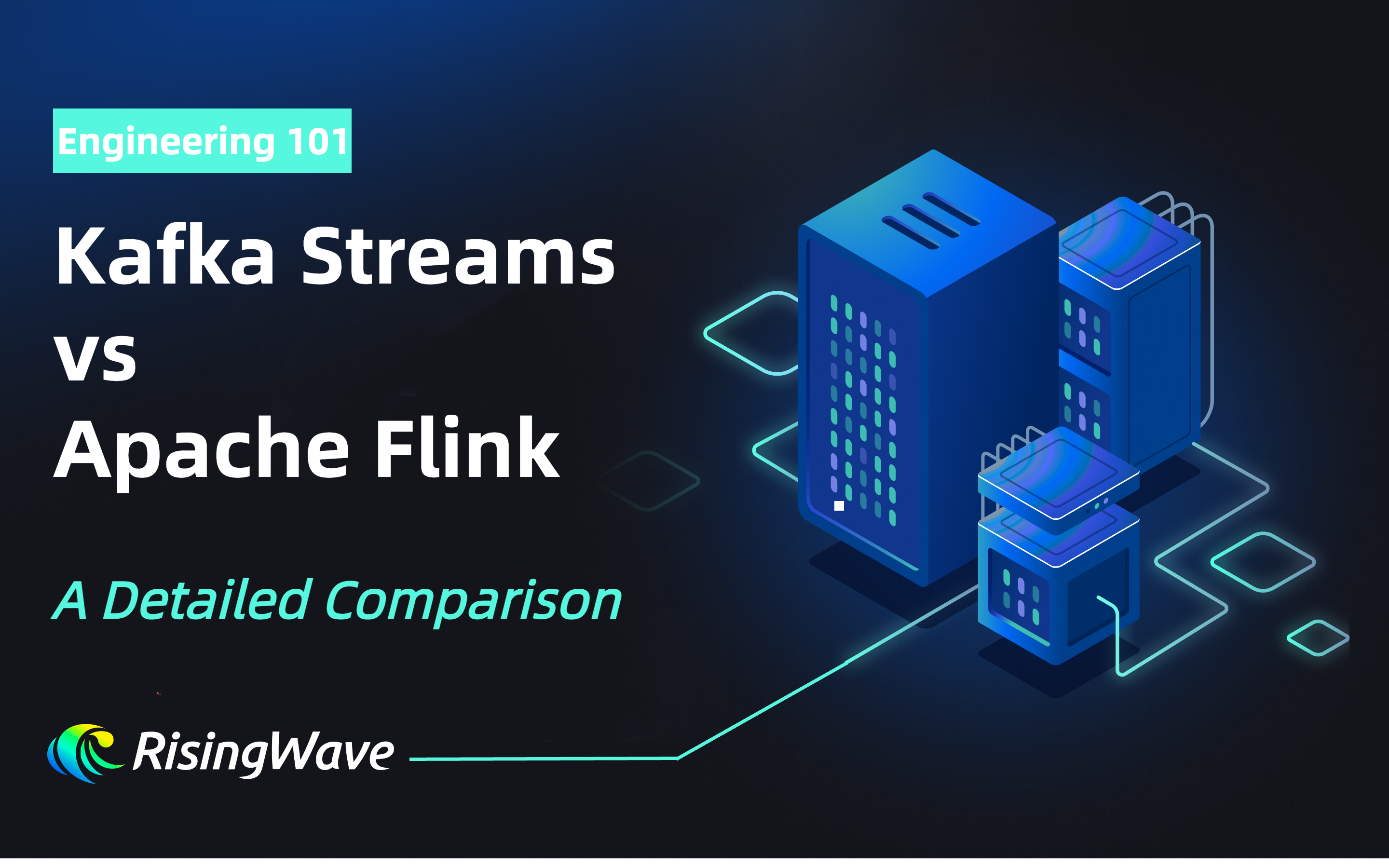Introduction to Stream Processing
In today's data-driven world, the global Big Data market is expected to grow by 9% in 2024. The volume of data created worldwide is projected to reach 147 zettabytes, and it is estimated that by 2025, our global data volume will soar to 175 zettabytes. These staggering figures underscore the critical importance of real-time stream processing in managing and deriving insights from such massive volumes of data.
The Importance of Stream Processing in Today's Data-Driven World
Real-time stream processing plays a pivotal role in handling the exponential growth of data. Unlike batch processing, which involves processing large volumes of data at once, leading to higher latency, real-time stream processing ensures constant input, processing, and output of data in milliseconds, resulting in minimal latency. This capability is crucial for organizations looking to harness the power of live data streams for immediate decision-making and actionable insights.
Furthermore, the demand for real-time stream processing is fueled by the need for instant responses and insights from current or recent data packets. With batch processing requiring more storage and computational resources for large data batches, real-time stream processing offers an efficient alternative that demands less storage and computational resources.
Basics of Real-Time Stream Processing
Real-time stream processing differs significantly from batch processing as it requires only a few milliseconds for processing compared to the longer time needed for batch processing. It involves handling tasks on the fly, enabling instantaneous responses that are essential in today's fast-paced business environment.
The comparison between batch and real-time stream processing highlights the advantages offered by real-time stream processing over traditional batch methods. As organizations continue to grapple with unprecedented volumes of data creation and consumption globally, embracing real-time stream processing becomes imperative for staying competitive and extracting meaningful insights from this deluge of information.
Understanding Kafka Streams
Real-time stream processing is a critical component of modern data-driven applications, and Kafka Streams has emerged as a powerful tool for processing streaming data within the Apache Kafka ecosystem.
What is Kafka Streams?
Kafka Streams is a lightweight yet robust library and stream processing engine designed for building standard Java applications. It provides developers with the tools they need to create a variety of applications, including microservices, reactive stateful applications, and event-driven systems. This powerful and embeddable system can be used for microservices, reactive stateful applications, and event-driven systems. It is a native component of Apache Kafka, which allows it to be scalable and fault-tolerant, as it relies on its distributed architecture.
Key Features of Kafka Streams
- Integration with Apache Kafka: Kafka Streams is tightly integrated with Apache Kafka for processing streaming data.
- Lightweight Design: The lightweight design of Kafka Streams makes it an ideal choice for stream processing activities.
- Scalability and Fault Tolerance: As an integral part of Apache Kafka, it inherits the scalability and fault tolerance capabilities of Kafka’s distributed architecture.
Use Cases for Kafka Streams
- Mission-Critical Stream Processing Applications: The Kafka Streams API is a compelling choice for building mission-critical stream processing applications.
- Efficient Processing in Moderate Workloads: It offers efficient processing for moderate workloads and real-time analytics within the Apache Kafka environment.
- Streamlined Real-Time Data Processing: It is inherently designed to work with Apache Kafka, leading to straightforward setups and configurations for those already using Kafka.
How Kafka Streams Works
The Architecture of Kafka Streams
Kafka Streams operates as an embeddable library within the Apache Kafka platform. This means that it does not require external frameworks or libraries to process streaming data. Instead, a Kafka Streams job functions as a standalone application that can be orchestrated at the user’s discretion.
Strengths and Limitations
One key strength of Kafka Streams lies in its seamless integration with any application within the Apache Kafka environment. However, its lightweight design may limit its ability to handle heavyweight tasks compared to other stream processing frameworks.
Exploring Apache Flink
Apache Flink is an advanced stream processing framework that excels in handling large-scale data processing tasks effectively. It is a distributed processing engine for stateful computations over unbounded and bounded data streams, designed to run in all common cluster environments, perform computations at in-memory speed, and at any scale.
What is Apache Flink?
Apache Flink stands out as a fully-stateful framework that can store the state of the data during processing, making it ideal for applications that require complex calculations or data consistency. Unlike Kafka Streams, which is partially-stateful and more specific to stream processing, Apache Flink offers a more generalized framework that can be used for various applications, including log processing, real-time data processing, and data analytics.
Key Features of Apache Flink
- Unified Stream and Batch Data Processing: Apache Flink is an open-source framework with powerful stream- and batch-processing capabilities. It runs self-contained streaming computations that can be deployed on resources provided by a resource manager like YARN, Mesos, or Kubernetes.
- Native Integration with Various Technologies: Apache Flink offers native integration with a wide range of technologies such as Hadoop, RDBMS, Elasticsearch, Hive, and more through the utilization of the Flink Connectors suite. These connectors function as sources within Flink pipelines.
- Fully-Stateful Framework: With its ability to store the state of the data during processing, Apache Flink is well-suited for applications requiring complex calculations or maintaining data consistency.
Use Cases for Apache Flink
Apache Flink's roots are in high-performance cluster computing and data processing frameworks. It was specifically developed to focus on real-time data and stateful processing, making it an ideal solution for processing large amounts of data. The framework is commonly used with Kafka as the underlying storage layer but remains independent of it.
How Apache Flink Works
The Architecture of Apache Flink
Apache Flink operates as a distributed computing system capable of processing large amounts of data in real-time with fault tolerance and scalability. Its architecture allows it to run in all common cluster environments while performing computations at in-memory speed and at any scale.
Strengths and Limitations
One notable strength of Apache Flink lies in its ability to deliver high throughput at scale (up to tens of millions of events per second) with sub-second latency as low as tens of milliseconds while ensuring accurate results. However, it requires a data ingestion tool like Kafka or Redpanda for complete efficiency.
Kafka Streams vs. Apache Flink: Key Differences
Performance and Scalability
When comparing Kafka Streams and Apache Flink, it becomes evident that they are designed to solve orthogonal problems and have very different sweet spots and placement in the data infrastructure stack. Flink is generally considered to be more performant than Kafka for streaming analytics applications, offering more advanced capabilities and suitability for a wider range of applications. It delivers high throughput at scale, handling tens of millions of events per second with sub-second latency as low as tens of milliseconds while ensuring accurate results.
On the other hand, Kafka Streams offers smoother integration and simpler operation for environments heavily invested in Kafka. It is generally considered easier to learn and use compared to Flink. However, its lightweight design may limit its ability to handle heavyweight tasks compared to other stream processing frameworks.
Data Processing Capabilities
In terms of data processing capabilities, Apache Flink stands out with its advanced features in stateful processing, windowing, and complex event processing. Its fully-stateful framework allows it to store the state of the data during processing, making it ideal for applications requiring complex calculations or maintaining data consistency. On the other hand, while Kafka Streams provides efficient processing for moderate workloads and real-time analytics within the Apache Kafka environment, it may not offer the same level of advanced capabilities as Flink.
Cluster Management and Scalability
Both frameworks ensure high availability and fault tolerance but employ different approaches. While Kafka Streams delegates to the capabilities of Kafka brokers for these aspects, Apache Flink depends on external systems for persistent state management and relies on systems like Zookeeper or Kubernetes for achieving high availability.
Use Cases and Application Scenarios
Ideal Scenarios for Kafka Streams
Kafka Streams is an excellent choice for small to medium-sized projects that require real-time data processing within the context of the Kafka ecosystem. It is particularly well-suited for mission-critical stream processing applications that demand efficient processing in moderate workloads while leveraging the power of Apache Kafka's distributed architecture.
Ideal Scenarios for Apache Flink
On the other hand, Apache Flink shines in large-scale projects that require complex stateful computations and event-time processing. Its broader range of advanced features makes it suitable for applications such as log processing, real-time data processing, and data analytics where high throughput at scale with sub-second latency is essential.
Ease of Use and Integration
Developer Experience and Learning Curve
When considering developer experience and learning curve, Kafka Streams offers a more straightforward learning path due to its seamless integration with any application within the Apache Kafka environment. Conversely, while Apache Flink may have a steeper learning curve due to its more advanced capabilities, it provides developers with a powerful framework capable of handling a wide range of complex stream-processing tasks.
Ecosystem and Community Support
Both frameworks enjoy strong ecosystem support; however, due to its native integration with various technologies such as Hadoop, RDBMS, Elasticsearch, Hive, among others through its connectors suite,**Apache Flink's ecosystem support appears more extensive than that offered by Kafka Streams.
Choosing Between Kafka Streams and Apache Flink
When considering a stream processing framework, several factors come into play to determine the most suitable option for a specific use case. Both Kafka Streams and Apache Flink are powerful open-source frameworks with their strengths and weaknesses for real-time stream processing, catering to different project requirements and goals.
Factors to Consider When Choosing a Stream Processing Framework
Project Size and Complexity
The size and complexity of the project are crucial determinants when choosing between Kafka Streams and Apache Flink. Flink is more suited for large-scale, complex processing due to its broader range of advanced features in stateful processing, windowing, and complex event processing. Its fully-stateful framework allows it to store the state of the data during processing, making it ideal for applications requiring complex calculations or maintaining data consistency. On the other hand, Kafka Streams is well-suited for small to medium-sized projects that demand efficient processing in moderate workloads within the context of the Kafka ecosystem.
Specific Requirements and Goals
The specific requirements and goals of a project play a significant role in determining which stream processing framework is best suited. For instance, if high throughput at scale with sub-second latency is essential, especially in scenarios such as log processing, real-time data processing, or data analytics, Apache Flink may be the preferred choice due to its advanced checkpointing strategy and horizontal scalability capabilities. Conversely, if seamless integration with any application within the Apache Kafka environment is a priority, then Kafka Streams offers a more straightforward learning path due to its native integration with Apache Kafka.
When exploring Kafka Streams, it becomes evident that it is a lightweight yet robust library and stream processing engine designed for building standard Java applications. Its seamless integration with Apache Kafka makes it an ideal choice for mission-critical stream processing applications and efficient processing within the Apache Kafka environment. > > On the other hand, Apache Flink stands out as an advanced stream processing framework capable of handling large-scale data processing tasks effectively. With its fully-stateful framework and powerful stream- and batch-processing capabilities, Apache Flink is well-suited for applications requiring complex calculations or maintaining data consistency. > > The comparison between Kafka Streams and Apache Flink has highlighted their differences in performance and scalability. While Apache Flink is generally considered more performant than Kafka Streams for streaming analytics applications, offering high throughput at scale with sub-second latency as low as tens of milliseconds while ensuring accurate results, Kafka Streams offers smoother integration and simpler operation for environments heavily invested in Kafka.






